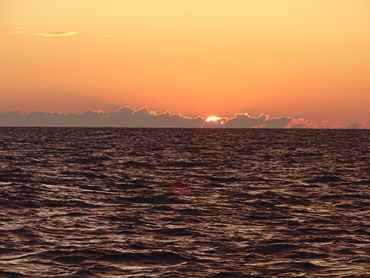Pottering south

Rosinis heads to Svalbard
Bob Hendicott
Tue 11 Sep 2018 19:09
|
If it feels as if I’ve been pottering gently back down the East coast it’s
because I have. This is not a coastline I’ve sailed on very much and I
don’t suppose I shall sail here much again unless it’s en route to somewhere
else. To be honest it’s not terribly interesting unless you sail a shoal
draft yacht, and one of those wouldn’t have got me to the Arctic quite as
comfortably as Rosinis has. So this has been my chance to look at places I
otherwise wouldn’t have got to.
I left Whitby at 0500 when the bridge opened for the last time on the early
morning high tide, having enjoyed fish and chips ashore the previous evening.
Every second shop in Whitby seems to be a fish and chip shop, but at least it’s
all good local produce! Once at sea it was a fast beam reach along the
coast and I ticked off the various landmarks in quick succession, starting with
a lovely sunrise off Robin Hood’s Bay at 0620 (how the nights are lengthening:
midnight sun seems an age ago now!); then Scarborough at 0800, and Flamborough
Head at midday. From there my course for Lowestoft diverged from the
coast, and in any case visibility dropped as rain squalls came in from the
north, mostly avoiding us but still reducing visibility. Next came the gas
fields, with production platforms and survey vessels keeping me on my toes as
they emerged from the mist. As the evening closed in the wind rose and
before long I had 30+knots across the deck and we were down to 2 reefs in the
main and a heavily rolled genoa. My original route had taken me across
some shallow areas, but in the conditions it seemed wise to re-plan and stay in
deeper water – the Outer Dowsing Channel – and by just after 2200 I spotted
Cromer lighthouse 20nm away on the north Norfolk coast. So far the tide had been
with me, but it then turned against and slowed progress considerably. It
wasn’t until almost first light the following morning that I was back in fair
tide, now driving Rosinis fast along the Norfolk coast: first Caister Road, then
past Great Yarmouth and finally into Lowestoft. Having stopped at Oulton
Broad (inland from Lowestoft) on the way north, I decided to stop this time at
the Royal Norfolk and Suffolk Yacht Club where I was made very welcome.
The clubhouse is a magnificent listed building: it’s a pity about the rest of
Lowestoft, where 20 minutes on a Sunday afternoon was more than
sufficient.
Yesterday I was away at 0640 to take the tide south. Again, it was a
landmark-spotting sail at great speed with the tide: Southwold by 0800; Sizewell
with its nuclear power station an hour later, and Orford Ness by 1015. My
route then diverged again from the coast, tracking through the dense shipping
lanes of the Sunk Traffic Separation Schemes which handle all the deep draft
shipping from London and Tibury, and all shipping from Harwich and
Felixstowe. In comparison with my north-bound passage at night, it was a
simple route in daylight and by early afternoon when the tide turned against us,
I was through the worst, having dodged the many wind farms and shoal
patches. By 1640 the Kent coast was visible and shortly after I was able
to play the tidal streams to my advantage, bringing Rosinis into the Royal
Harbour marina at Ramsgate almost exactly at low water at 2200. Again I
was reminded how shallow many of these east coast harbours are.
The strong winds forecast for today materialised into a gale warning at
0700 this morning. I’d always planned a rest day today and, had the
forecast been different, I’d probably have stayed another day in Lowestoft so I
could invite Jane and Steve (sister and brother-in-law) to dinner in the
RN&SYC> Instead I’ve enjoyed a sunny, but very windy day in
Ramsgate where the swell in the harbour at high water has been
substantial. Tomorrow I shall head through Dover Strait and onto the south
coast: the last stretch of this marathon expedition.
The attached photos show the wonderful sunrise off the Yorkshire coast; one
of the many gas well-heads I passed; and the colossal Londay Array Wind Farm in
the Thames estuary. There wasn’t much else that was greatly photogenic so
the camera didn’t spend much time on deck. |



